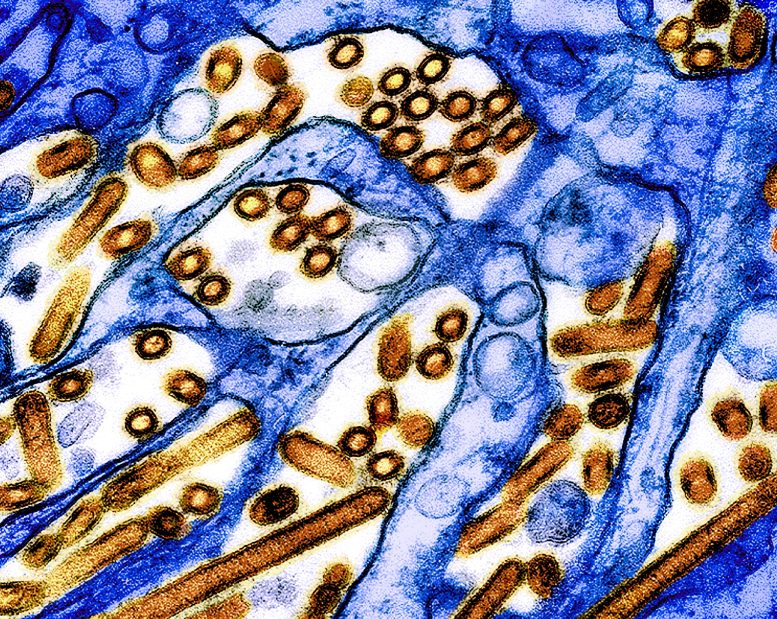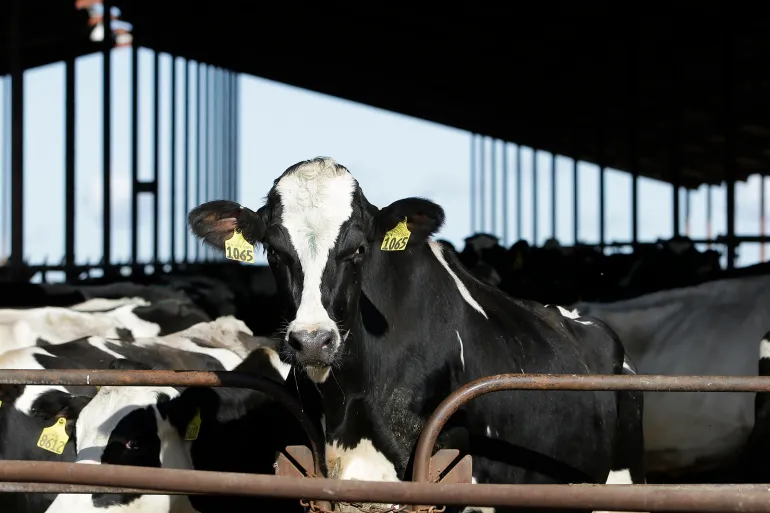An experiment that infected U.S. cattle with H5N1 influenza revealed here that even though it caused severe disease in mice and ferrets, it fails to transmit effectively through respiratory droplets. This finding would suggest, therefore, that the risk of the bovine-originated viral isolates evolving into a mammalian-transmissible epidemic virus is relatively low.
Results of the Experiment of H5N1 Infection in U.S. Dairy Cattle
This study, involving a series of experiments with highly pathogenic H5N1 avian influenza (HPAI H5N1) viruses arising from infected U.S. dairy cattle, showed that viruses derived from lactating dairy cattle, when inoculated intranasally, caused severe disease in both mice and ferrets. The virus came from the H5N1-infected cows, attaching to avian and human-type cellular receptors, but it did not show a certain number of transmissions among the ferrets that were exposed via respiratory droplets.
The results, published in the July 8 issue of the journal Nature, show that the detected bovine HPAI H5N1 viruses are clearly distinguishable from previously known HPAI H5N1 viruses, and these viruses have some characteristics that may help acquisition of infection and transmission among mammals. At present, though, they do not seem to be able to transmit efficiently by respiratory droplets from animal to animal or person to person.
There was an H5N1 HPAI outbreak in US dairy cattle in March 2024, which, along with the ensuing spill-over into poultry, killed some cats and infected 4 dairy workers. The isolated HPAI H5N1 viruses from the affected cattle share close identity with the H5N1 viruses that have proved to be circulating in North American wild birds since 2021. Over time, these avian viruses have undergone many genetic changes and diversification and expanded their geographical distribution, enabling regular outbreaks in wild birds and mammals, some with mortality and inter-species transmission at presumed rates.

Overview
One- to two-sentence summaries of research methods and animal model results.
The characteristics of the bovine H5N1 viruses generated interest that led researchers at the University of Wisconsin-Madison; Japan’s Shizuoka and Tokyo Universities; and Texas A&M Veterinary Medical Diagnostic Laboratory to examine replication and pathogenicity of bovine HPAI H5N1 in mice and ferrets, which typically are used for studies of the influenza A virus. The ferret is known to be an excellent model for studying possible characteristics of person-to-person influenza transmission dynamics in humans because of very similar clinical symptoms and immune responses, coupled with the development of similar respiratory tract infections.
Scientists intranasally administered increasing doses of bovine HPAI H5N1 influenza to mice (5 mice per dosage group) and followed the animals in the study for changes in body weight and survival over a period of 15 days. All the mice in the groups that received higher doses of the virus died as a consequence of the infection. Some of the mice that received lower doses survived, while those that received the lowest dose did not lose body weight and lived.
Comparative Studies and Transmission Tests
The results of this group using the bovine HPAI H5N1 virus were compared with those obtained with a Vietnamese H5N1 strain that was more typical of H5N1 avian influenza virus that was known to cause human infections and a H1N1 influenza virus, giving otherwise converted intranasally in mice. In contrast to this, the mice infected with either the bovine HPAI H5N1 virus or the Vietnamese avian H5N1 virus showed high levels of the virus in respiratory and non-respiratory organs, such as in mammary glands and muscle tissues, and occasional in the eyes. The H1N1 virus was present only in respiratory tissues of the animals.
Ferrets infected with the bovine HPAI H5N1 virus through the intranasal administration made remarkably high degrees of temperature and profound loss in body weight. Just like in the mice, a significantly high quantity of the virus was isolated in the upper and lower respiratory tissues of the ferrets and other sections of the body organs. Contrary to with the mice, such viruses were not isolated in the blood and muscular tissues.
The researchers did so by testing whether or not the bovine H5N1 viruses transmitted among mammals through droplets of the respiratory system by infecting between groups of ferrets with either bovine HPAI H5N1 virus or H1N1 influenza, which is already known to transmit efficiently through the respiratory droplet spread and placing an uninfected ferret in a cage adjacent to one day after the infection with each infected animal. Infected ferrets in all groups co-infected with influenza viruses developed clinical disease and high levels of virus detection in nasal swabs over a period of several days. However, clinical disease appeared only in ferrets co-housed with H1N1-infected consignments, indicating that infection with the cow influenza virus did not transmit efficiently by the respiratory droplet route among ferrets.
Usually, an.
The researcher, however found that the bovine HPAI H5N1 viruses have the capacity to bind on either, raising some concerns on the possibility that the capability for binding on man’s upper respiratory cells might had already been acquired by the virus.
“Collectively, our study demonstrates that bovine H5N1 viruses may differ from previously circulating HPAI H5N1 viruses by possessing dual human/avian-type receptor-binding specificity with limited respiratory droplet transmission in ferrets,” the authors said.
The pertinent study found that while viruses from U.S. cattle could be used to cause infections in mice and ferrets, the poor replication efficiency of the H5N1 influenza virus and subsequent spread via respiratory droplets significantly restricts this ability. This is an important distinction, for only lowly efficient are the bovine-derived viruses capable of causing serious diseases by their direct transmission between individual mammals.
Moreover, the outbreak in the United States involving dairy cattle in March 2024 revealed spillover from the poultry population to mammalian hosts, such as cattle and cats, where the virus caused fatal infections in these animals, followed by another spillover event from cattle populations back to poultry. In the United States, four workers from those associated with dairy cattle were infected, with two showing limited human-to-human transmission. The closely matched H5N1 viruses recovered from wild birds in North America since late 2021 have had a diversity of genomic alterations over the past few months, likely contributing to the disease found in both wild bird and mammal populations.
The experimental design the University of Wisconsin-Madison, and Japan’s Shizuoka and Tokyo Universities followed to achieve this was to administer varying doses of a bovine HPAI H5N1 influenza intranasally to mice. It was observed that with higher doses, the infection proved lethal to all the mice, whereas those that received lower doses show survival without the loss of much weight. Ferrets, being another animal model because of their similarity to humans in the pattern of influenza transmission, also developed severe symptoms and the systemic viral spread on infection with the bovine H5N1 virus.
These findings not only expanded the understanding of pathogenic potential by bovine HPAI H5N1 viruses but also underscored the necessity of sustained surveillance and research to monitor their evolution and potential threats to public health. The findings of such a study, regarding the receptor-binding specificity of the virus to both avian and human cell receptors, further raise concerns over the adaptability of the virus and the potential risks of spillover to human populations.
